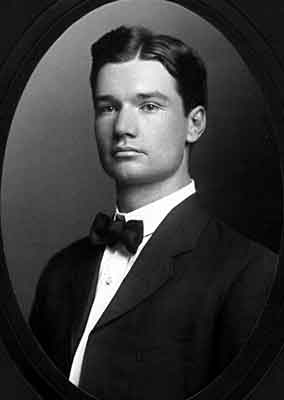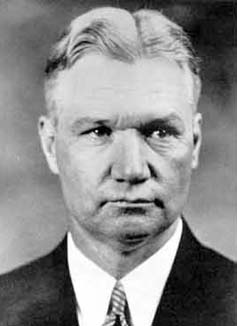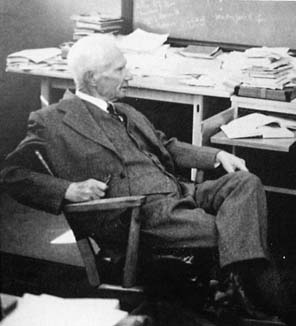<Back to Index>
- Mathematician Robert Lee Moore, 1882
- Poet Aleardo (Gaetano Maria) Aleardi, 1812
- Mathematician and Member of Parliament Ulisse Dini, 1845
PAGE SPONSOR



Robert Lee Moore (14 November 1882 – 4 October 1974) was an American mathematician, known for his work in general topology and the Moore method of teaching university mathematics.
Although Moore's father was reared in New England and was of New England ancestry, he fought in the American Civil War on the side of the Confederacy. After the war, he ran a hardware store in Dallas, then little more than a railway stop, and raised six children, Robert being the fifth.
Moore entered the University of Texas at the unusually low age of 16, in 1898, already knowing calculus thanks to self - study. He completed the B.Sc. in three years instead of the usual four; his teachers included G.B. Halsted and L.E. Dickson. After a year as a teaching fellow at Texas, he taught high school for a year in Marshall, Texas.
An assignment of Halsted's led Moore to prove that one of Hilbert's axioms for geometry was redundant. When E.H. Moore (no relation), who headed the Department of Mathematics at the University of Chicago, and whose research interests were on the foundations of geometry, heard of Robert's feat, he arranged for a scholarship that would allow Robert to study for a doctorate at Chicago. Oswald Veblen supervised Moore's 1905 thesis, titled Sets of Metrical Hypotheses for Geometry.
Moore then taught one year at the University of Tennessee, two years at Princeton University, and three years at Northwestern University. In 1910, he married Margaret MacLelland Key of Brenham, Texas; they had no children. In 1911, he took up a position at the University of Pennsylvania.
In 1920, Moore happily returned to the University of Texas at Austin as an associate professor, and was promoted to full professor three years later. In 1951, he went on half pay, but continued to teach his habitual five classes a year, including a section of freshman calculus, until the University authorities forced his definitive retirement in 1969, his 87th year. In 1973, the University of Texas honored him by giving the name Moore Hall to a new building housing the physics, mathematics, and astronomy departments.
A strong supporter of the American Mathematical Society, he presided over it, 1936 – 38. He edited its Colloquium Publications, 1929 – 33, and was the editor - in - chief, 1930 – 33. In 1931, he was elected to the National Academy of Sciences.
According to the bibliography in Wilder (1976), Moore published 67 papers and one monograph, his 1932 Foundations of Point Set Theory. He is primarily remembered for his work on the foundations of topology,
a topic he first touched on in his Ph.D. thesis. By the time Moore
returned to the University of Texas, he had published 17 papers on point - set topology — a
term he coined— including his 1915 paper "On a set of postulates which
suffice to define a number - plane," giving an axiom system for plane topology. The Moore plane, Moore's road space, Moore space and the Moore space conjecture are named in his honour.
Robert Lee Moore is known to have supervised 50 doctoral dissertations, almost all at Texas, including those of R.H. Bing, F. Burton Jones, John R. Kline, Mary Ellen Rudin, Gordon Whyburn, R.D. Anderson, and Raymond Louis Wilder. This attests to Moore's having been one of the most charismatic and inspiring university teachers of mathematics ever active in the United States. Moore had a breathtaking ability to teach students who had never previously distinguished themselves in mathematics how to do proofs. He went out of his way to teach elementary and service courses every year, and actually forbade his students from consulting the mathematical literature.
It was while attending lectures at the University of Chicago that Moore first hit on his original teaching methods. Finding these lectures rather boring, even mind dulling, he would liven up a lecture by running a race in his mind with the lecturer, by trying to discover the proof of an announced theorem before the lecturer had finished his presentation. Moore often won this silent race, and when he did not, he felt that he was better off from having made the attempt. It was at the University of Pennsylvania, while teaching a course on the foundations of geometry, that Moore first tried out the teaching methods that came to be known as the Moore method. The success of this method led others to adopt it and similar methods.
Moore's
record as a teacher of mathematics has been tarnished by his attitude
towards black students, which is considered extreme even for the
standards of the then widespread anti - black racism in America. He was a
virulent racist and explicitly refused to teach African Americans. He
once famously walked out of a lecture once he realized the speaker was
black.
- "That student is taught the best who is told the least."
- "I hear, I forget. I see, I remember. I do, I understand." (Chinese proverb that was a favorite of Moore's)
- "You are welcome to take my course but you start with a C and can only go down from there." Moore, in response to W.E. Hunt's intention to take a Topology course Moore taught, quote in S. W. Williams R. L. Moore: racist mathematician unveiled (2005). W.E. Hunt was black, and later went on to become a Professor of Mathematics.